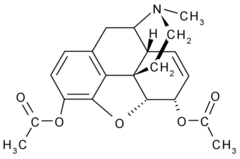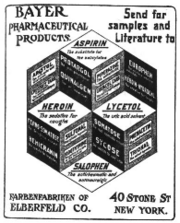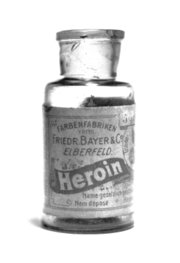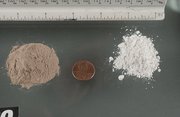MEETING HER NOW, IT IS HARD TO BELIEVE THAT THE Mexican-Russian great-granddaughter of the revolutionary Leon Trotsky ever felt the need to impress her friends. But the universal teenage urge to look more glamorous drove a young NoraVolkow, then in high school, to smoke her first cigarette. It could have been the first step toward a nasty habit, but something in her neurochemistry rebelled. She hated it.
Volkow, now one of the country's most prominent drug addiction researchers and the new director of the National Institute on Drug Abuse (NIDA), doesn't think that her disgust for cigarettes had anything to do with morals or self-control. She says she's just naturally intense; the additional stimulation provided by the nicotine was simply too much for her. "I like coffee, but I cannot even drink it because I get so wired," she says. "I was probably born like that. I'm very protected against drugs. It's my neurobiology, and I'm lucky."
Listening to her explain her theories about addiction and the brain, her self-diagnosis sounds right on target. Even though she's petite, with a jogger's lean physique, she dominates the room. She speaks very fast, with a Spanish accent that rounds her vowels, and ideas tumble out one after the other so quickly that it's almost impossible to keep up.
She's a fast-moving example of one of her most interesting theories: that addiction may be a malfunction of the normal human craving for stimulation. Volkow thinks that drugs and other addictive habits tap into some of the deepest forces within us--our lust for newness, our yearning for vitality and the deep-down thrill of being alive. "We all seek that intensity," she says. "There's something very powerful about that."
This idea is based on a new understanding of dopamine, the brain chemical involved in motivation, pleasure and learning. Because addictive drugs like cocaine and nicotine cause a flood of dopamine in the brain, researchers once thought that the neurochemical was a simple pleasure switch, the body's own "reward" button. Yet something didn't add up. If dopamine delivers the pleasure message, addicts should be in a continual state of bliss--but most of them get very little pleasure from the drug, despite the surge of neurochemicals. "I've seen hundreds of addicted people, and never have I come across one who wanted to be addicted," says Volkow. As she began doing brain-imaging studies with drug addicts, that contradiction haunted her.
In response, Volkow and other researchers are developing a new understanding of addiction. Rather than just telling us to feel good, dopamine tells us what's salient--the unexpected bits of new information we need to pay attention to in order to survive, like alerts about sex, food and pleasure, as well as danger and pain. If you are hungry and you get a whiff of a bacon cheeseburger, Volkow's research team has shown, your dopamine skyrockets. But the chemical will also surge if a lion leaps into your cubicle. Dopamine's role is to shout: "Hey! Pay attention to this!" Only as an afterthought might it whisper "Wow, this feels great." So maybe addicts aren't just chasing a good time. Perhaps their brains have somehow mistakenly learned that drugs are the most important thing to pay attention to, as crucial to survival as food or sex.
The salience theory of dopamine also provides new explanations for other self-destructive human tendencies, from binge eating to gambling. It may explain why we crave the stimulation of new information. The experiments that Volkow and her team are conducting may also reveal some of the most powerful behavioral machinery in our brains, the equipment that motivates and inspires us. If they are right, dopamine is more than a joyride. It's more like the drug of life. Its mission is more profound and philosophical: to connect us to the world and supply us with the will to stay alive.
NORA VOLKOW, now 48, has science in her blood. Her father is a chemist, her grandfather and her great-grandfather were physicists. But her family, which emigrated from Russia to Mexico in the 1930s, has another intellectual legacy. One of her great-grandfathers was the brilliant Bolshevik leader Leon Trotsky, and Volkow grew up in the Mexico City home where he spent the last days of his life--and where he was killed on Stalin's orders in 1940. Parts of the house became a museum of Trotsky's life, and when Volkow was a child, people like the Nobel Prize-winning novelist Gabriel Garcia Marquez would stop by.
Volkow, though, was more interested in psychiatry than in politics. She graduated at the top of her medical school class at the National University of Mexico, then came to the United States to pursue the new science of brain imaging. During the 1980s, at New York University and then at University of Texas, Austin, she used brain imaging techniques to study schizophrenia and cocaine addiction--and established herself as a leader in the field. She then moved to Brookhaven National Laboratory in Upton, New York, where she won a reputation as an intellectual powerhouse, respected for her creativity as well as for her productivity. "Nora has that enthusiasm, that spark," says NYU Medical Center psychiatry chair Robert Cancro, who worked with her early in her career. "She'd get excited about things, talk 160 words a minute--and that was in English!"
Her colleagues say she is a bold and unconventional thinker. Early on, she demonstrated that cocaine physically damaged the brain. It took years before this controversial finding was accepted, but other research eventually proved her right. She was also an early champion of the idea that drug addiction is a medical problem, rather than a lack of willpower or moral fiber. That formerly radical view is now considered mainstream.
Since she was chosen to direct NIDA last year, Volkow has brought new visibility to the controversial theory about dopamine that has percolated in the scientific community for approximately the past decade. According to the salience theory of dopamine, the neurochemical is released when something surprisingly important happens, whether that's an unexpected reward or accidentally stepping on a nail. Since dopamine is also involved in learning, memory and motivation, the chemical helps us pay attention to the information we need to survive, act upon it, and remember it for the future. But drugs hijack that machinery, sending 5 to ten times as much dopamine surging through the nucleus accumbens and forcing the brain's motivational and attentional mechanisms to focus purely on the drug. It becomes the most interesting and important thing in the world. "In any addicted person, what's salient is the drug," says Volkow. "There's no competition."
Over time, the addict's brain adapts to the torrent of dopamine by dampening the system down. Imaging experiments show that cocaine addicts' brains don't react to the things that turn on the rest of us, whether that's romantic passion, food or cold, hard cash. Volkow's research has also shown that addicts have fewer dopamine D2 receptors, which are found in parts of the brain involved in motivation and reward behavior. With fewer receptors, the dopamine system is desensitized, and the now-understimulated addict needs more and more of the drug to feel anything at all. Meanwhile, pathways associated with other interesting stimuli are left idle and lose strength. The prefrontal cortex--the part of the brain associated with judgment and inhibitory control--also stops functioning normally. It's a neurological recipe for disaster. "You have enhanced motivation for the drug, and you have impaired prefrontal cortical systems. So you want the drugs pathologically, and you have reduced control of behavior, and what you've got is an addict," says University of Michigan, Ann Arbor psychology professor Terry Robinson, who pioneered this new way of thinking about dopamine with his University of Michigan colleague Kent Berridge.
Some people are apparently born with fewer dopamine receptors, and they are more likely to enjoy the rush of addictive drugs. In one imaging experiment, Volkow gave Ritalin, which gently lifts dopamine levels, to a group of ordinary volunteers. Some loved the feeling of the drug, but others hated it so much that they threatened to drop out of the study. Volkow was puzzled until she imaged their brains. She found that those who liked the rush from the drug had fewer dopamine D2 receptors than those who hated it. Volkow thinks that some people have a sensitive dopamine circuitry; they can't take the additional stimulation of drugs.
Obesity may involve similar malfunctions in the dopamine system. Volkow's longtime Brookhaven collaborator Gene-Jack Wang has discovered that the brains of seriously obese people seem to be tuned toward food. Even when they are lying quietly in the scanning machine, the sensory cortex of their mouth, tongue and lips is more active than it is in normal-weight people, he says: "They are putting out their antennae." Yet he also found that the dopamine circuitry of heavy people is less responsive, with fewer dopamine D2 receptors. Even among the obese, there are dopamine differences. The heaviest people in his study had fewer dopamine receptors than the lightest. Like addicts, overeaters may be compensating for a sluggish dopamine system by turning to the one thing that gets their neurons pumping.
It's a mark of changing times--and more sophisticated science--that the head of the National Institute on Drug Abuse is thinking about doughnuts as well as heroin, lust as blaming drug addiction on moral weakness was a shortsighted and unscientific way of framing a social problem, Volkow believes that focusing solely on metabolism, or blaming fat people for overindulgence and gluttony, are intellectual dead ends. "What motivates us to eat is clearly much more than hunger," she says. "We need to expand the way we think about eating." Wang and Volkow suggest that dopamine may provide a new window into weight loss: Animal studies have shown, for example, that exercise elevates dopamine release and increases dopamine D2 receptors.
Volkow and the other champions of the new view of dopamine don't deny that the chemical helps us register pleasure. But they think that pleasure is just part of a set of interconnected dopamine-related behaviors. Volkow recently found that adults with attention deficit disorder who took dopamine-boosting Ritalin before taking a math test found it easier to concentrate, in part, because the task seemed more interesting, so they felt more motivated to do the problem.
From this angle, it makes sense that the cognitive process of absorbing new information is closely tied to the brain's pleasure mechanisms. You might say that what the brain really "wants" is new information, suggests Gregory Berns, associate professor of psychiatry and behavioral sciences at Emory University in Atlanta. "Neurons really exist to process information. That's what neurons do. If you want to anthropomorphize neurons, you can say that they are happiest when they are processing information."
This urge to connect to the world and learn from it is more important than mere pleasure, says Volkow. It's part of the most basic force in behavior: the will to live. It's not automatic, she points out. Seriously ill or very depressed people can lose the will to survive. "What is the motivation we all have to be alive, to do things?" she asks. "It's not pleasure. Our lives would be so much simpler if we were motivated just for the sake of pleasure."
But dopamine sensitivity and addiction aren't genetically determined or inevitable. One experiment with monkeys showed that the dopamine system may be influenced by social interactions: Animals that lost social status also lost D2 receptors. Context is also crucial. Obviously, it's easier to get hooked if drugs are easy to get in your neighborhood, but it's not just a question of supply and demand. People who grow up in stimulating, engaging surroundings are protected against addiction, Volkow believes, even if they don't have a naturally responsive dopamine system. If you connect to the world in a meaningful way, and have more chances to get excited about natural stimuli, you're less likely to need an artificial boost.
"If you don't get excited by everyday things in life, if things look gray, and the drug makes things look extraordinary, that puts you at risk," she says. "But if you get great excitement out of a great multiplicity of things, and intensely enjoy these things--seeing a movie, or climbing a mountain--and then you try a drug, you'll think: What's the big deal?" For those lucky enough to grow up as Volkow did, surrounded by sharp minds and fascinating history, drugs are just nowhere near as interesting as everyday life.
RELATED ARTICLE: Conspiracy theories explained.
PARANOID SCHIZOPHRENICS are prone to delusions, tales in which random events become deeply meaningful. Some believe in complex conspiracies: others think they are Jesus Christ.
These stones sound crazy, but they may be the brain's efforts to make sense of its own internal messages, suggests Shitij Kapur, professor of psychiatry at the University of Toronto and vice president of research at the Canadian Centre for Addiction and Mental Health. In addition to other brain abnormalities, schizophrenics have too much dopamine. Just as addicts' desensitized dopamine systems make them feel that nothing matters, high levels of the neurotransmitter make schizophrenics believe that everything is significant.
Because the addict's dopamine-driven salience system keeps telling her that something very important is happening, ordinary events appear intensely meaningful. That police car? That song on the radio? That man with a cigarette walking by? They must be part of a massive international conspiracy.
Kapur calls it "biased inductive logic"--a top-down effort to explain the feeling that everything seems important. The cognitive parts of a schizophrenic's brain create the paranoid tale in an effort to explain the constant red alert blaring from the dopamine circuits, using any stimuli available. This is why delusions are culturally appropriate. African schizophrenics may fear they've fallen under the spell of a shaman, while Kapur's patients in Toronto think that the Mounties are after them.
Kapur cautions that this theory is still speculative, but it could support a radical idea: treating schizophrenia with cognitive therapy. If drugs control the overactive dopamine system, patients may then gradually unlearn their delusions.--KM
COPYRIGHT 2004 Sussex Publishers, Inc.
COPYRIGHT 2004 Gale Group




